Rotterdam is not, perhaps, the first place that you think of when planning your holiday in the Netherlands. Nevertheless, Rotterdam apart from being one of the largest ports in the world has a lot to offer to tourists. Rotterdam suffered in the First World War, but in the Second World War the bombings almost destroyed the centre of the city. Therefore, the current appearance of the city combines meticulously restored historic buildings and sites, like the Great Church of Rotterdam, Witte Huis, Old Harbour, and City Hall with the most innovative and creative examples of modern architecture, such as Rotterdam Centraal Station, Cube Houses, and Markthal Rotterdam.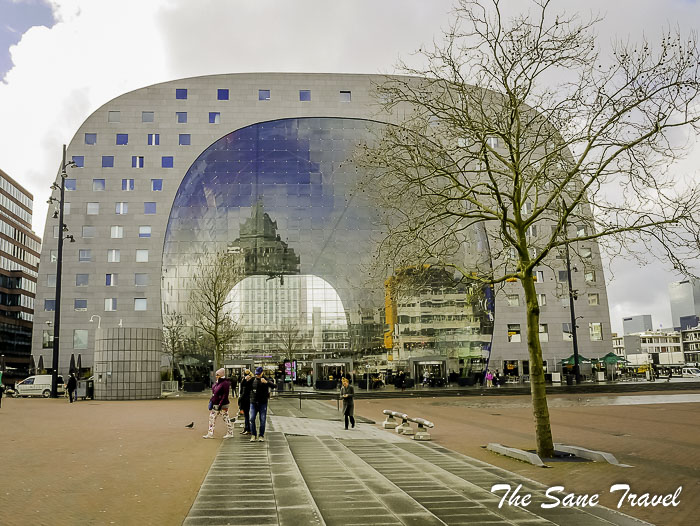 So let’s start to explore the cool city of Rotterdam with an excellent example of modern architecture: Rotterdam Centraal Station.
So let’s start to explore the cool city of Rotterdam with an excellent example of modern architecture: Rotterdam Centraal Station.
Rotterdam Centraal Station
It is very likely that you will arrive in Rotterdam by train, so start your exploration from the train station. When Rotterdam central rail hub had achieved its maximum capacity, it was decided to open a new complex including high-speed and commuter lines. After five year long construction, Rotterdam Centraal Station was opened in 2014. The centrepiece of the design is the main entrance’s shiny boomerang-like canopy, a stainless-steel projection that is warmed by a partial cladding of wood. At the train platforms, a transparent roof is supported by wood beams. Moreover, 130,000 solar cells are spread across the roof area, making this one of the largest rooftop solar projects in Europe. 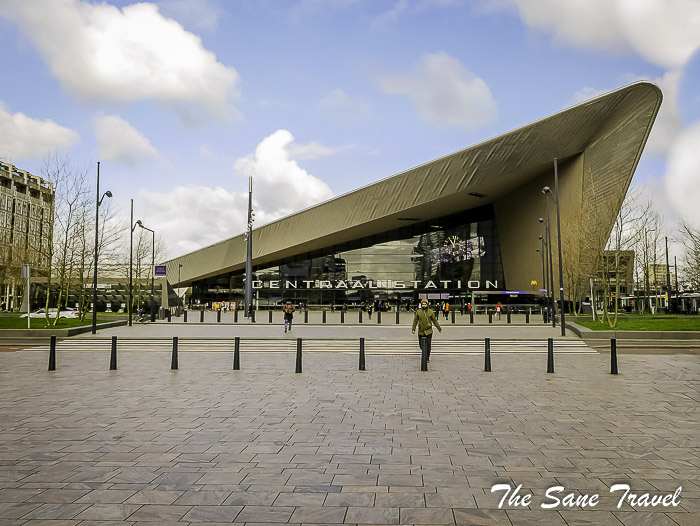
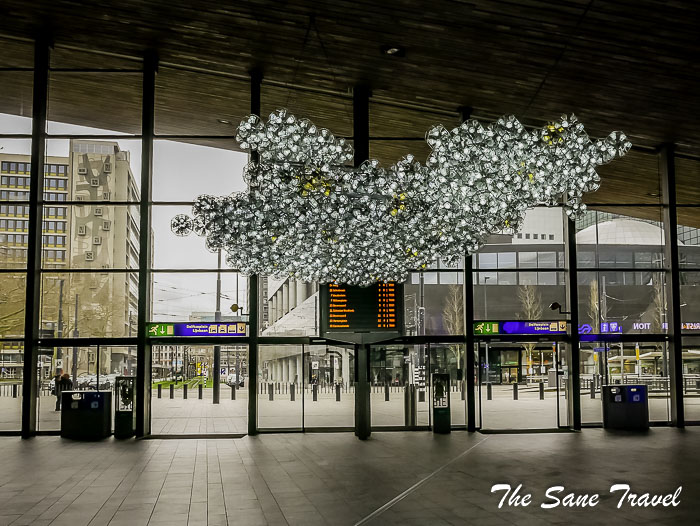
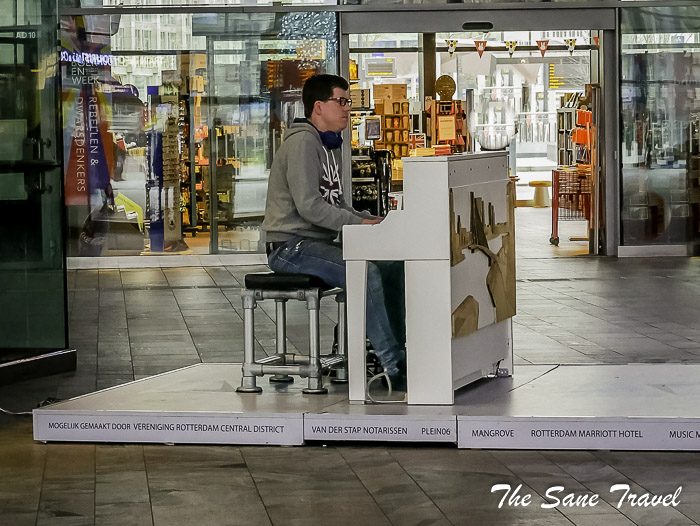 If you choose to visit just one area of Rotterdam, let it be Blaak Station with many tourist attractions close to each other. Let’s start with Markthal Rotterdam.
If you choose to visit just one area of Rotterdam, let it be Blaak Station with many tourist attractions close to each other. Let’s start with Markthal Rotterdam.
Markthal Rotterdam
Markthal Rotterdam is one of the newest icons of the city. It is situated at a historical location at the Binnenrotte, next to Blaak Station. 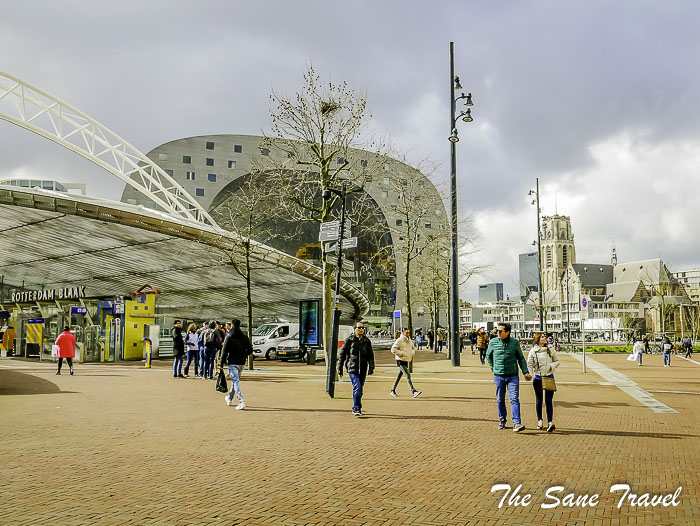 The complex accommodates a market hall, apartments, a parking garage, and the Horn of Plenty, the impressive artwork on the ceiling, the biggest work of art in the world. It is made by Arno Coenen covering 11,000 square meters of bright colours and shapes, sometimes called the Sistine Chapel of Rotterdam.
The complex accommodates a market hall, apartments, a parking garage, and the Horn of Plenty, the impressive artwork on the ceiling, the biggest work of art in the world. It is made by Arno Coenen covering 11,000 square meters of bright colours and shapes, sometimes called the Sistine Chapel of Rotterdam. 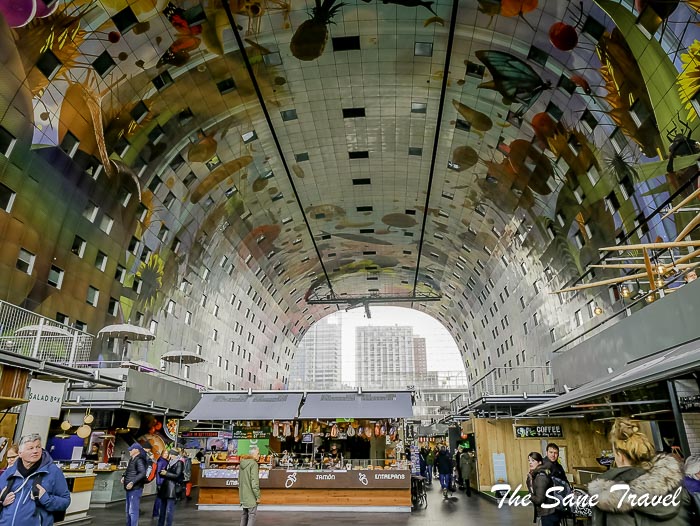

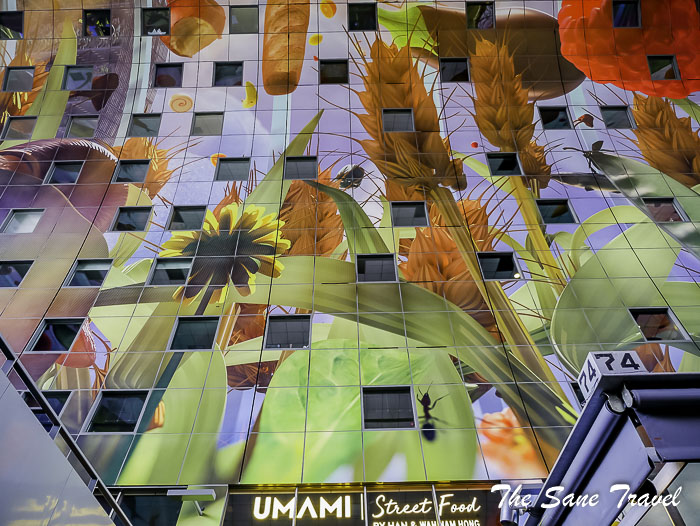 More than 100 stalls sell everything from Dutch cheese and stroopwafel to all kinds of international food. There are several restaurants and shops apart from the stalls. It feels great to just walk around and gaze at the great architecture of the horseshoe-shaped building and the artwork above. The arch is 120 meters long, 70 meters wide and 40 meters tall.
More than 100 stalls sell everything from Dutch cheese and stroopwafel to all kinds of international food. There are several restaurants and shops apart from the stalls. It feels great to just walk around and gaze at the great architecture of the horseshoe-shaped building and the artwork above. The arch is 120 meters long, 70 meters wide and 40 meters tall.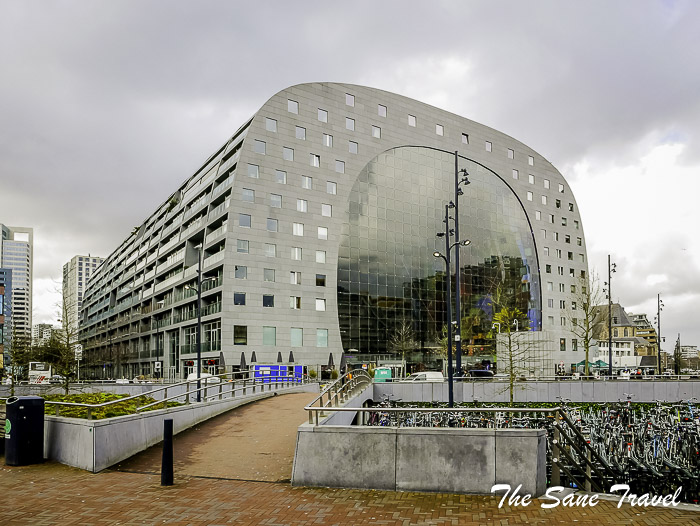
The Great Church of Rotterdam
The St. Laurenskerk or Great Church of Rotterdam is the only remaining medieval structure in the city. The Great Church was constructed in the late 15th and early 16th century, in the late gothic period. The church was severely damaged during the bombings in 1940. In 1952, the people of Rotterdam decided to restore the church to its former grandeur. 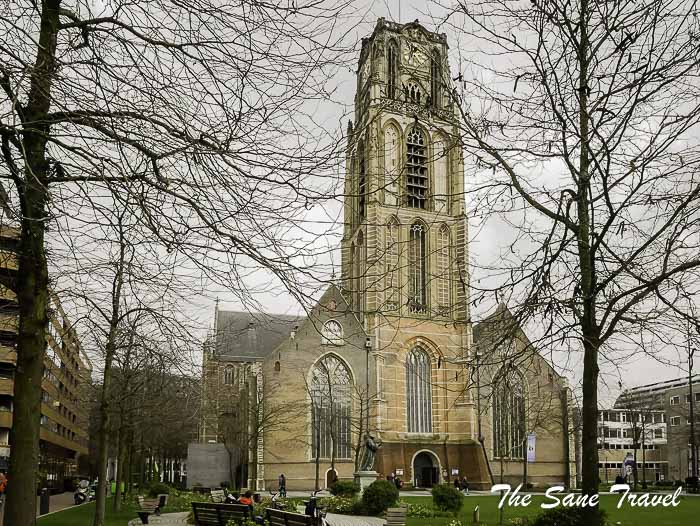
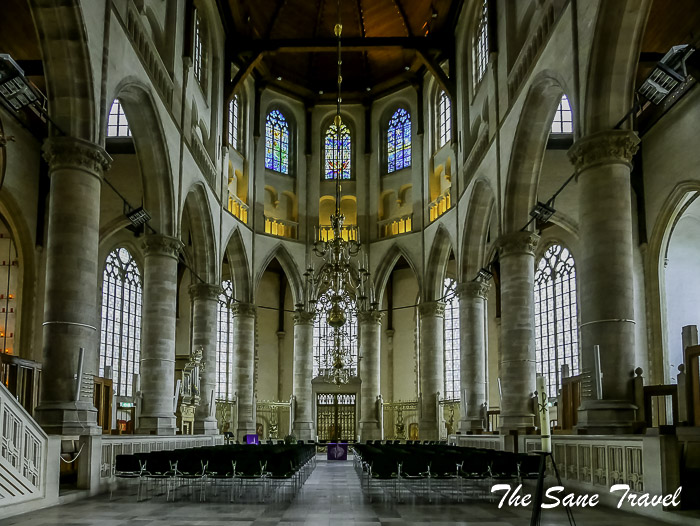
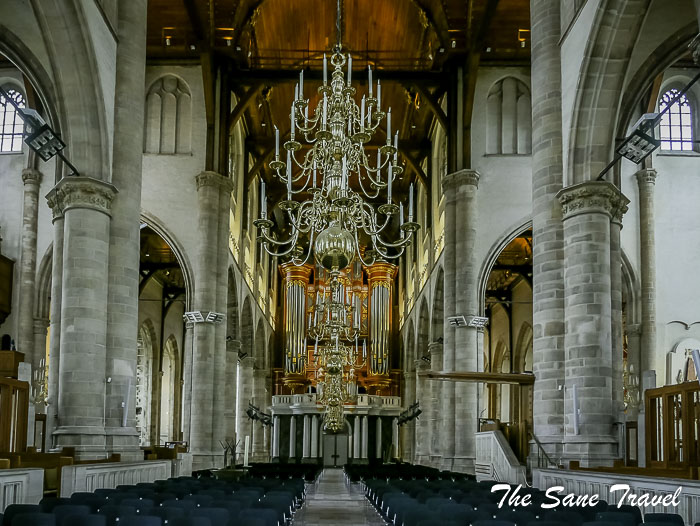 The St. Laurenskerk has four organs. With 7,600 pipes, the main organ is the biggest in the Netherlands and one of the biggest mechanic organs in the world.
The St. Laurenskerk has four organs. With 7,600 pipes, the main organ is the biggest in the Netherlands and one of the biggest mechanic organs in the world. 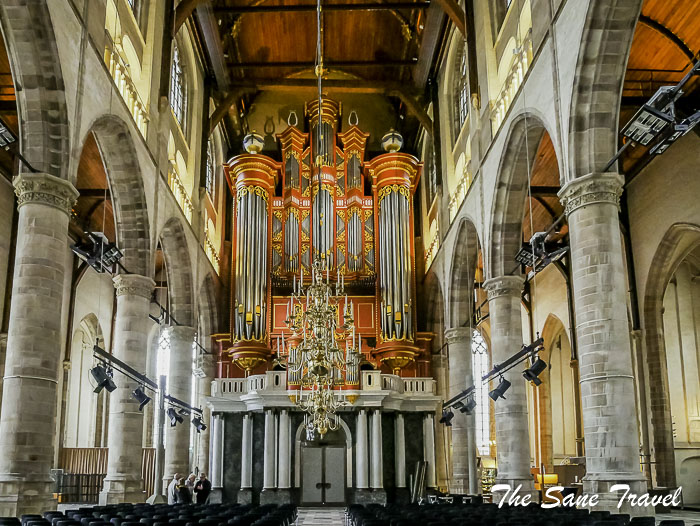 The Italian artist Giacomo Manzù designed the bronze doors of war and peace for the church in the 1960s. The door’s panels depict the horrors of war and the joys of peace. Also worth seeing are the 18th-century brass choir screen, the baptismal font of Hans Petri from the 1960s, the 17th-century tombs. The views on top of the church tower over Rotterdam are marvellous.
The Italian artist Giacomo Manzù designed the bronze doors of war and peace for the church in the 1960s. The door’s panels depict the horrors of war and the joys of peace. Also worth seeing are the 18th-century brass choir screen, the baptismal font of Hans Petri from the 1960s, the 17th-century tombs. The views on top of the church tower over Rotterdam are marvellous.
So let’s move to nearby Cube Houses now.
The Cube Houses
The Cube Houses (Kubuswoningen) in Rotterdam are one of the city’s most eye-catching developments. The Dutch architect Piet Blom designed Rotterdam’s Cube Houses in the 1970s at the request of the city’s planners. These striking homes are literally cubes, tilted over by 45 degrees. The Cube Houses were designed asymmetrically to resemble an abstract forest, each triangular roof representing a treetop. It is why locals also call them the Blaak Forest. 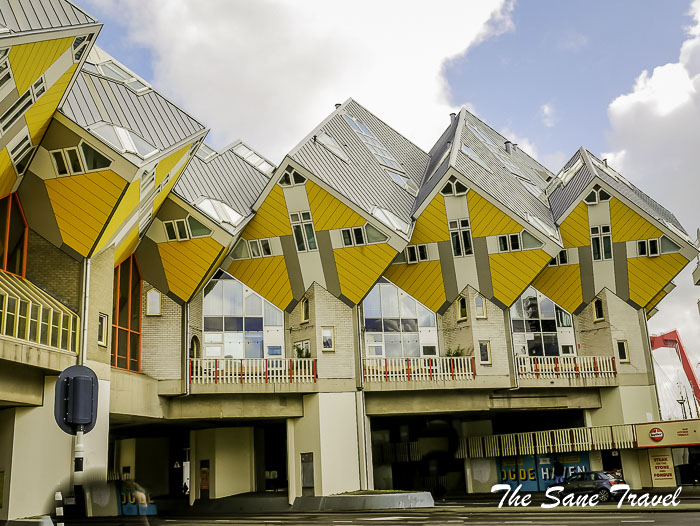
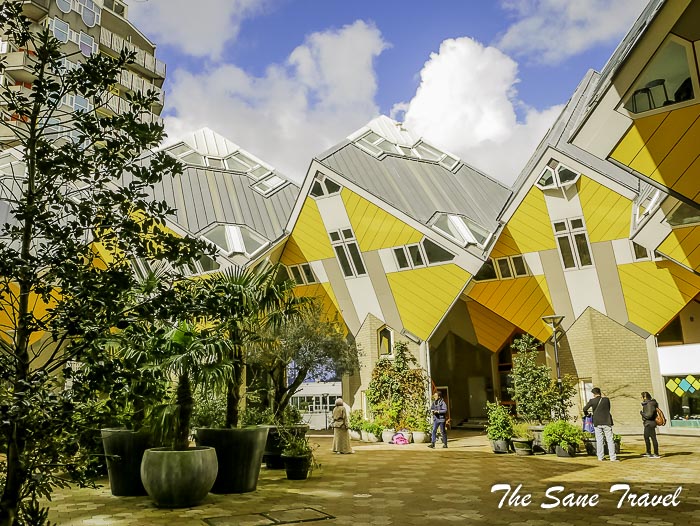
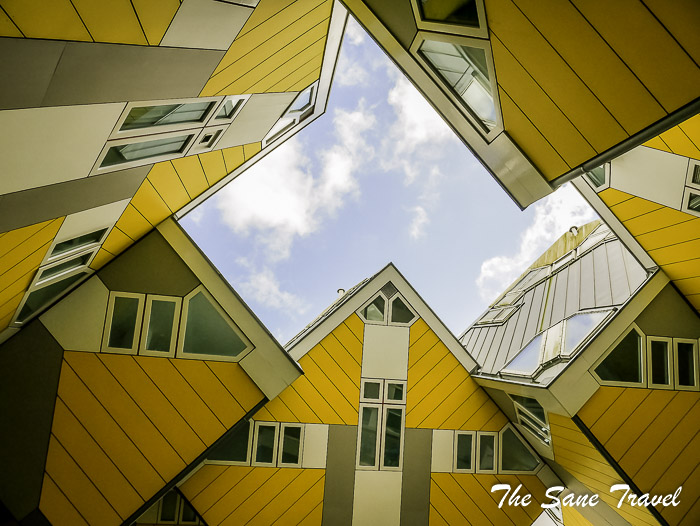 The Cube Houses include 38 houses and 13 office cubes. The area of each cube house is approximately 100 m2 with three floors. Curious visitors can learn more about these apartments by exploring the Show Cube Museum.
The Cube Houses include 38 houses and 13 office cubes. The area of each cube house is approximately 100 m2 with three floors. Curious visitors can learn more about these apartments by exploring the Show Cube Museum. 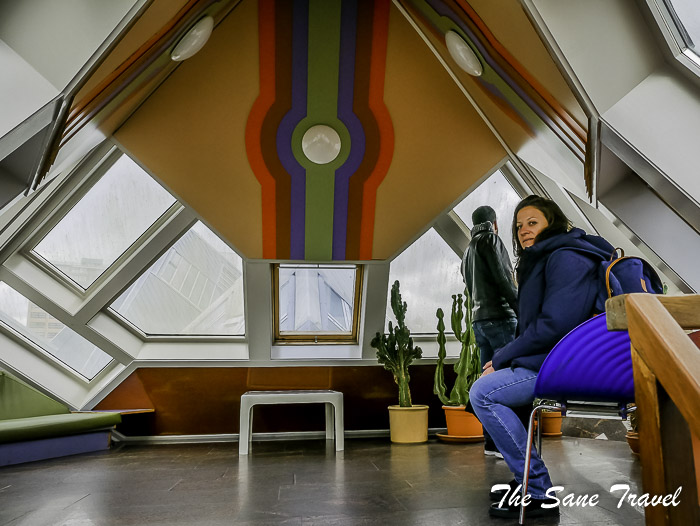 The Cube Houses even form a pedestrian bridge across one of the busiest roads from the city centre to the Old Harbour.
The Cube Houses even form a pedestrian bridge across one of the busiest roads from the city centre to the Old Harbour.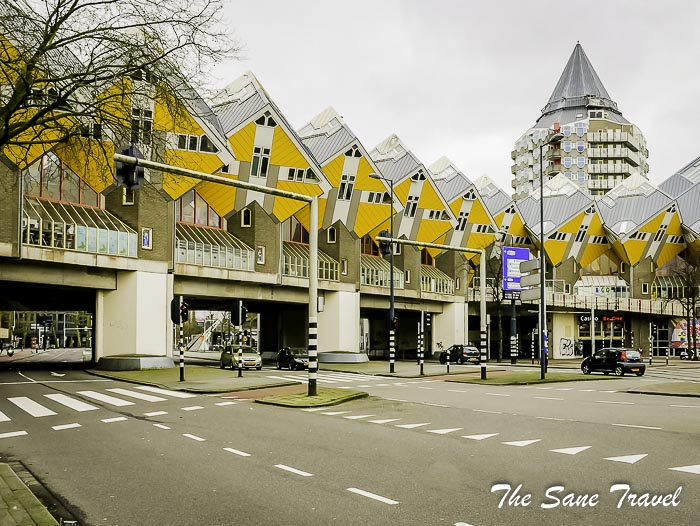
The Old Harbour
When you are visiting Rotterdam, the Old Harbour (Oude Haven) is a must-see location. This historic port is located in the centre of the city and is one of the most popular areas for locals to meet, eat, drink, and dance. Most bars and terraces are situated in front of the iconic Witte Huis and next to the Cube Houses. The old harbour was formed in the mid-14th century as a result of the damming of the river Rotte. To this day, you can still find historic ships there, mostly as part of the nearby Maritime Museum. The view of this historic fleet gives the Old Harbour in Rotterdam a unique feel. 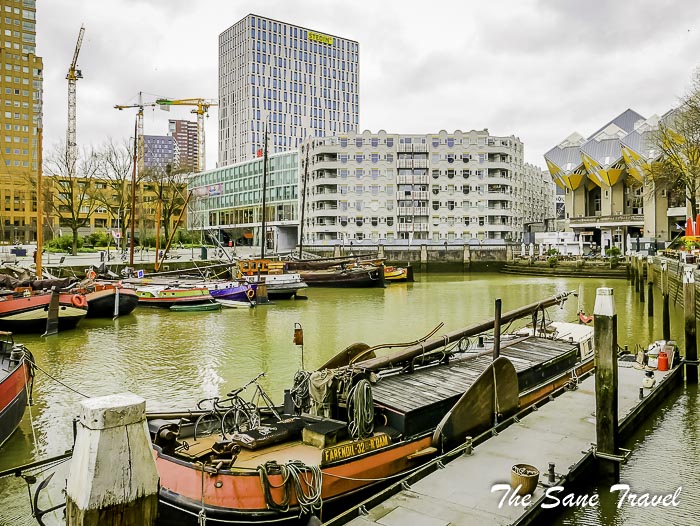
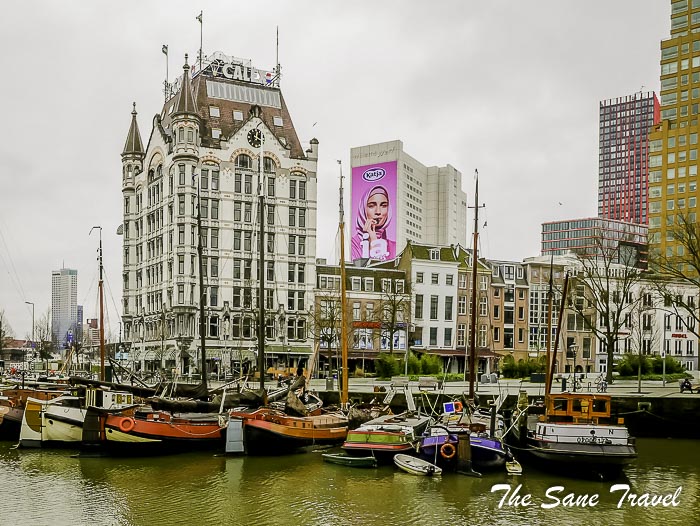
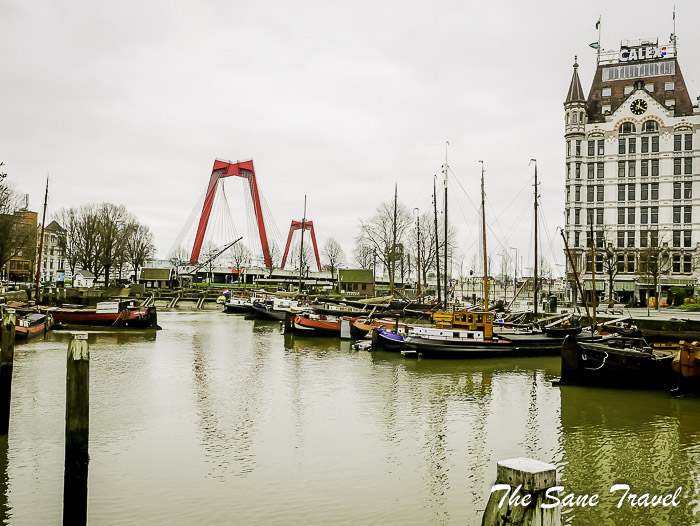 But what makes the Old Harbour really special is the mix of historic houses and modern design buildings.
But what makes the Old Harbour really special is the mix of historic houses and modern design buildings.
Witte Huis
Witte Huis or White House is one of a few buildings in Rotterdam’s city centre that survived the bombings during the Second World War. Its Art Nouveau style looks striking against a modern backdrop. At the end of the 19th century, Rotterdam’s White House was the tallest office building in the city and the first skyscraper in Europe to reach 43 metres in height. 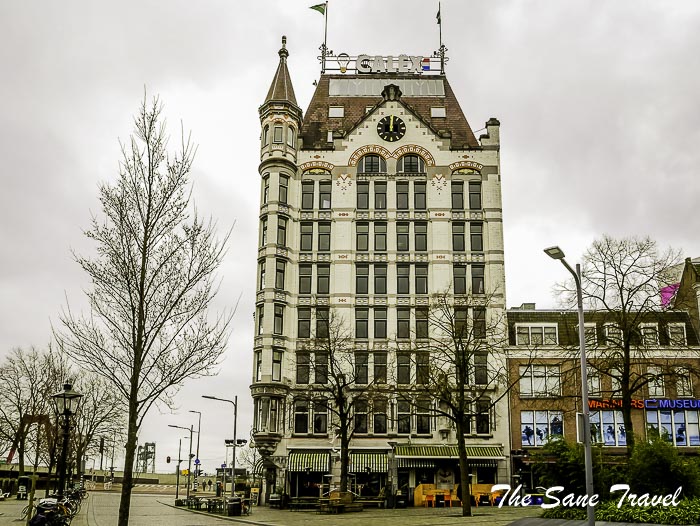
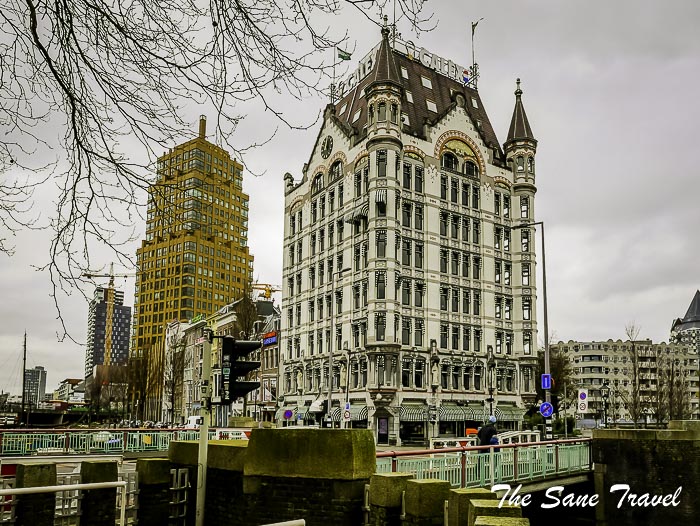 It has a beautiful façade of white glazed brick-tiles adorned with Art Nouveau mosaics and statues, and a modern observation platform atop the building’s flat roof. Visitors can enjoy the beautiful view of Rotterdam’s picturesque Oude Haven and enjoy a fine cup of coffee at the Grand Café Het Witte Huis on the ground floor.
It has a beautiful façade of white glazed brick-tiles adorned with Art Nouveau mosaics and statues, and a modern observation platform atop the building’s flat roof. Visitors can enjoy the beautiful view of Rotterdam’s picturesque Oude Haven and enjoy a fine cup of coffee at the Grand Café Het Witte Huis on the ground floor.
The Erasmus Bridge
One of the Netherlands’ most famous bridges, the Erasmus Bridge spans the River Nieuwe Maas and forms an important connection between the northern and southern parts of Rotterdam. Built from light-blue steel, the 800-meter-long Erasmus Bridge is a remarkable sight. At its highest point, the bridge is 139-meters tall. The bridge has also been affectionately nicknamed The Swan (De Zwaan) by locals due to the distinctive shape of its asymmetrical pylon.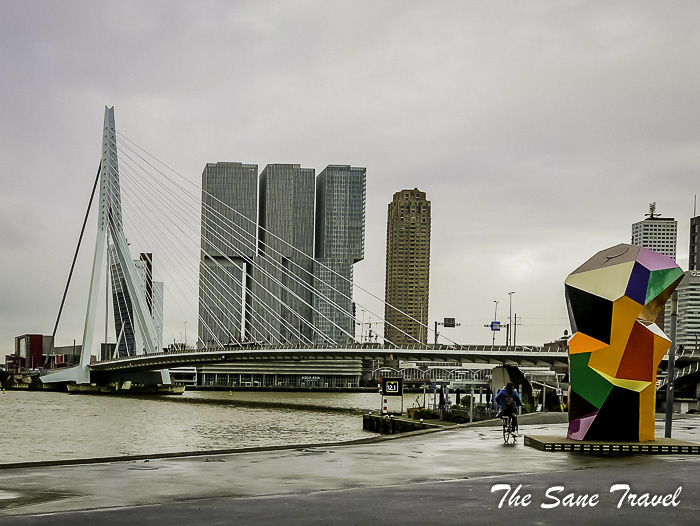
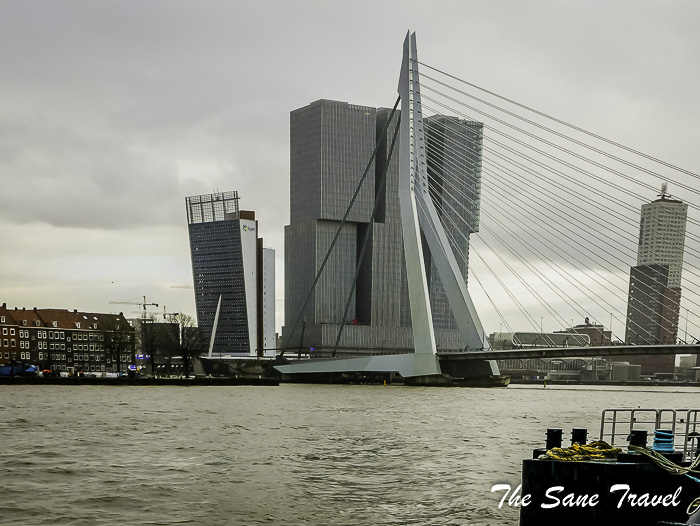
The City Hall
The City Hall (Stadhuis) in Rotterdam is one of a few buildings that were built before the Second World War. Built in the early 20th century, this Beaux-Arts style building has Byzantine, Romanesque, and Art Deco influences. The richly decorated, sand-coloured stone façade features various sculptures. The height of its tower is 71 meters. 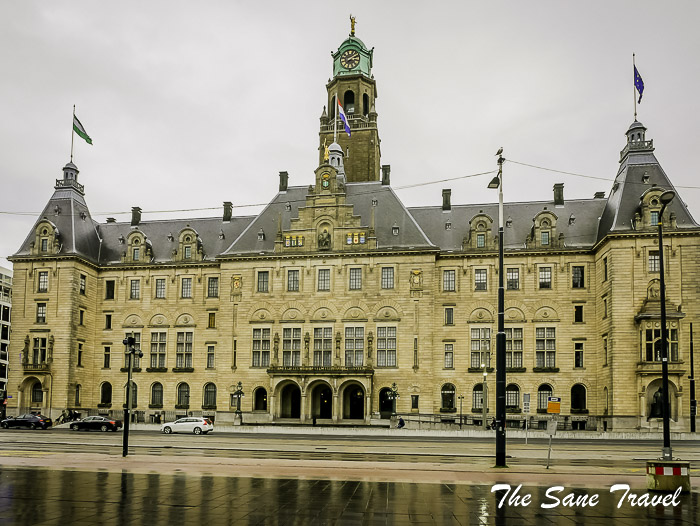 The City Hall is located on the Coolsingel, one of the most famous streets in Rotterdam.
The City Hall is located on the Coolsingel, one of the most famous streets in Rotterdam. 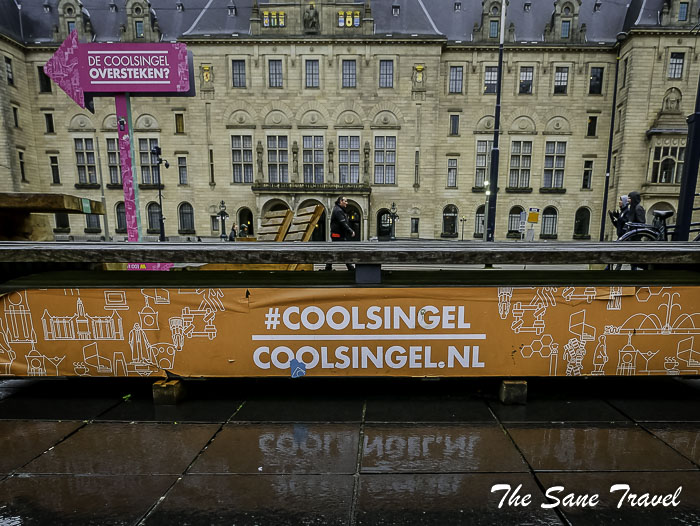 On this 900 metres long boulevard, you will find shops, restaurants as well as other important buildings, such as the Hilton and the old post office.
On this 900 metres long boulevard, you will find shops, restaurants as well as other important buildings, such as the Hilton and the old post office.
The Schielandshuis
The Schielandshuis is the only preserved building of the 17th century in the centre of Rotterdam. From the mid-17th century, this luxurious building accommodated the Water Authority (Hoogheemraadschap van Schieland). At that time, the building acquired the appearance of a city palace. It is why the French emperor Napoleon and Alexander, the Tsar of Russia, once slept in the Schielandshuis. The municipality of Rotterdam bought the building in 1840. A fierce fire in the mid-19th century caused a lot of damage. Only the walls remained. The municipality of Rotterdam brought the Schielandshuis back to its former glory in stages and reopened it as Museum Boymans and Museum Rotterdam. Today, a Rotterdam Tourist Information Centre is located in the building.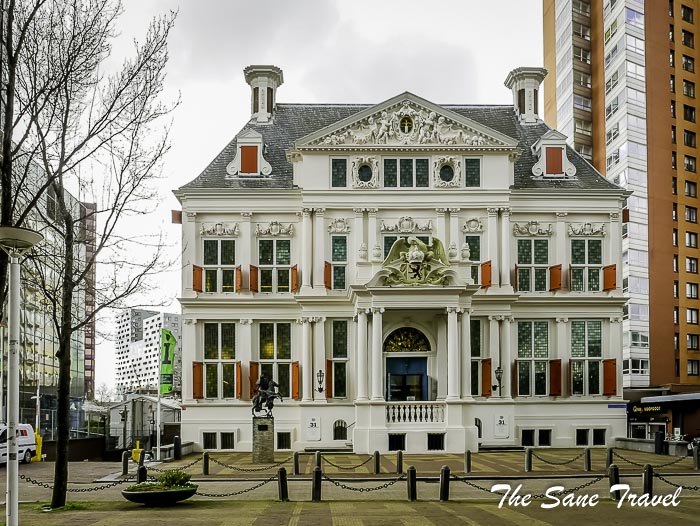 Notice the statue of count van Henegouwen William IV (1307-1345) who gave Rotterdam its city rights in 1340. The statue was unveiled in 1990.
Notice the statue of count van Henegouwen William IV (1307-1345) who gave Rotterdam its city rights in 1340. The statue was unveiled in 1990.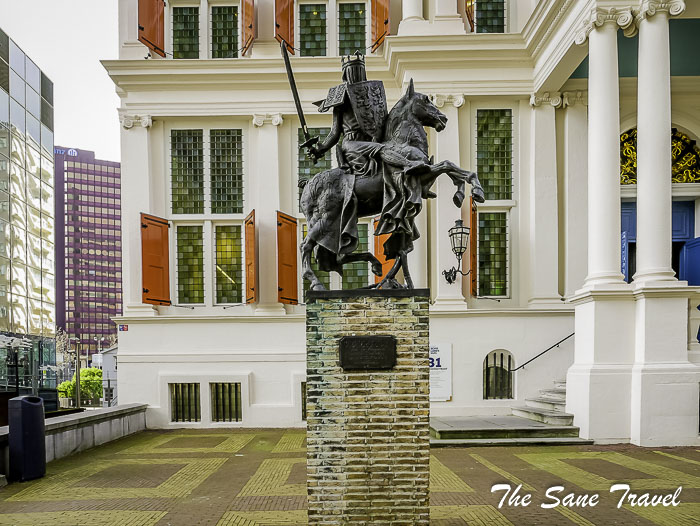
Street art
Street art is booming in Rotterdam. Travellers and locals like to share photos and videos of street art pieces on their social media accounts. You can take several routes to explore the street art of the city. At the Leuvehaven, you will spot the boat Antwerp’s SMOK used as a canvas for art. The Merwe-Vierhavengebied (also known as M4H) is an old city dock with a raw, industrial look. The long, wide walls of the old warehouses provided unique canvases for many artists. Afrikaanderwijk is a place where the second street art festival POW! WOW! of Rotterdam was held in 2019. Impressive murals made by artists from different countries, such as the Netherlands, Australia, the USA, Spain, etc. can be seen there. In the Central District located close to Rotterdam’s Centraal Station, you can find many murals. The artwork on Zwarte Paardenstraat was created by the Chilean artist Jorge Kata Nuñez and is called “El Trotamundos”, which means the world traveller. The galloping horse carries a world map on his body and a peace dove on his face. The artwork stands for freedom and global citizenship. 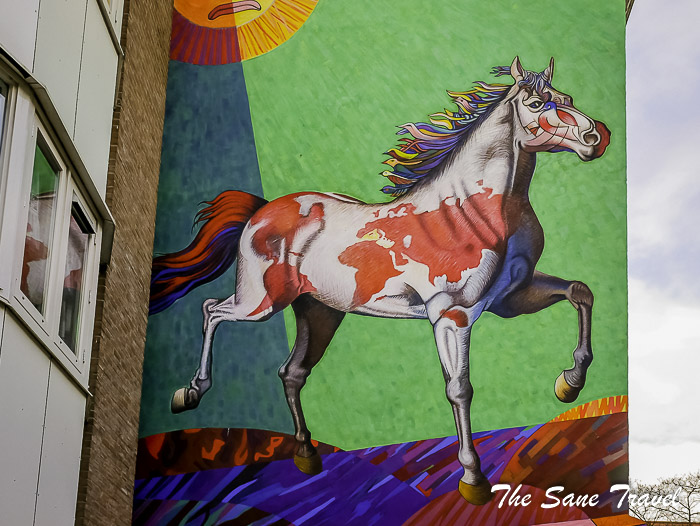 The nearby Witte de Withstraat has more street art per square metre than any other place in the city. An interesting piece of artwork is Mr. Merida made by Tymon Ferenc de Laat on the corner of Witte de Withstraat and Eendrachtstraat.
The nearby Witte de Withstraat has more street art per square metre than any other place in the city. An interesting piece of artwork is Mr. Merida made by Tymon Ferenc de Laat on the corner of Witte de Withstraat and Eendrachtstraat.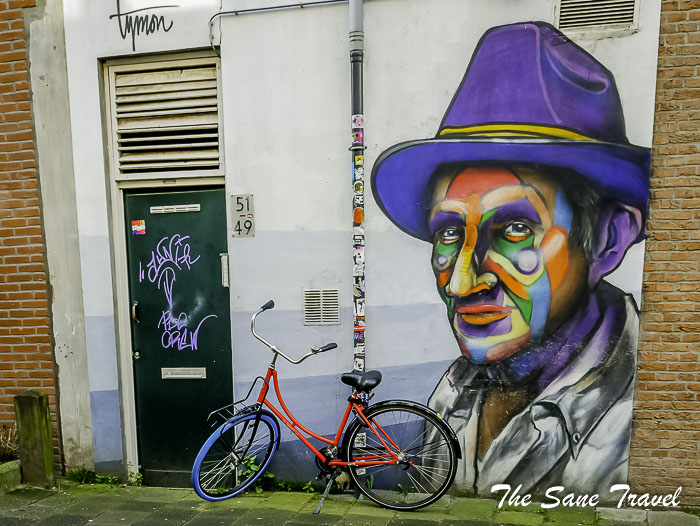 A mural of artist Lydia Schouten was moved to the corner of Witte de Withstraat and Eendrachtsstraat in 2005.
A mural of artist Lydia Schouten was moved to the corner of Witte de Withstraat and Eendrachtsstraat in 2005.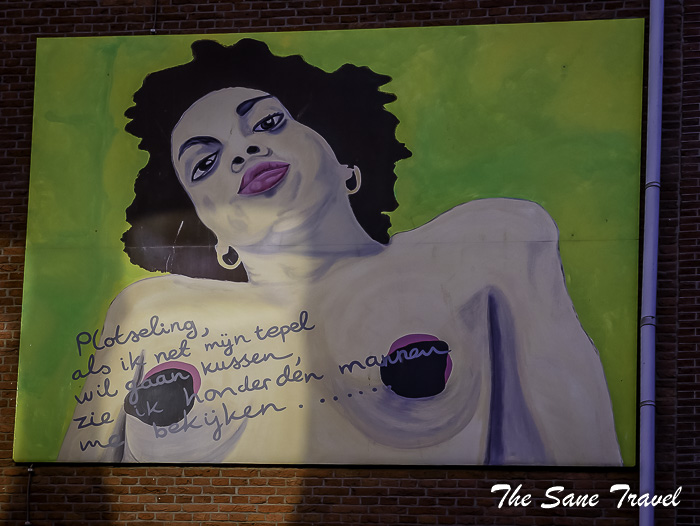
And finally, the statue locally known as the buttplug leprechaun happily guards the entrance to the Eendrachtstraat at the Eendrachtsplein Square. Let me explain something about it. The bronze statue of Santa Claus was intended to show a favourite bearded fat man holding a festive bell and a Christmas tree; however, the US artist Paul McCarthy replaced said Christmas tree with a giant butt plug. Many may see the clear similarity between the festive shrub and a least favoured sex toy. 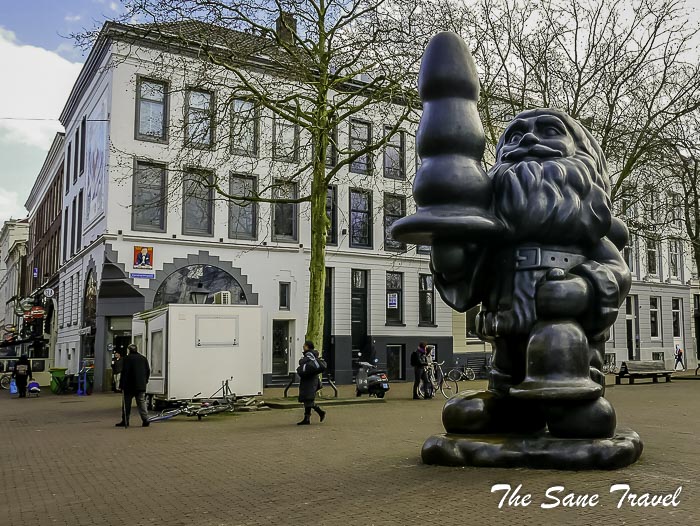 Remember to see many other statues and monuments in Rotterdam, like L’homme qui marche by Auguste Rodin (1905).
Remember to see many other statues and monuments in Rotterdam, like L’homme qui marche by Auguste Rodin (1905).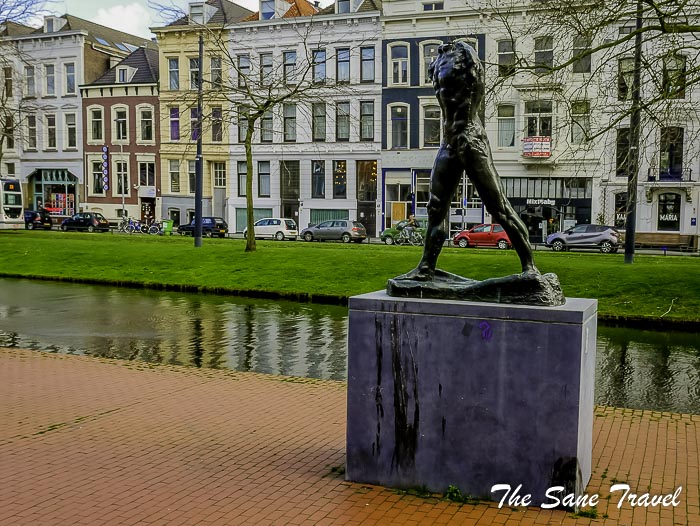 and La Grande Musicienne by Henri Laurens (1938).
and La Grande Musicienne by Henri Laurens (1938).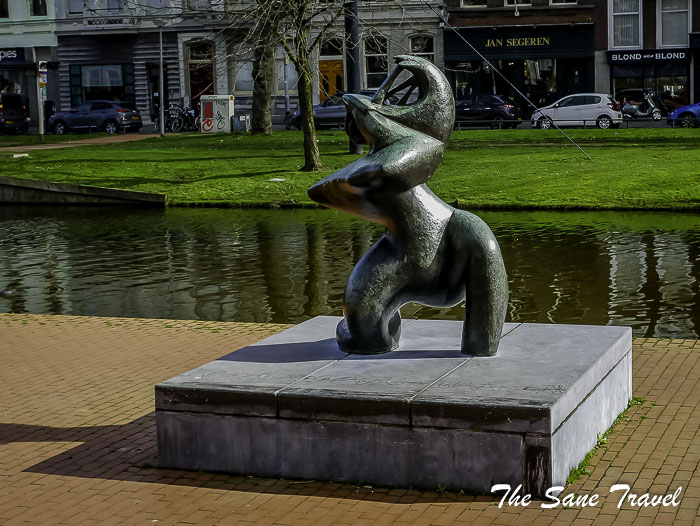
Like it? Pin it!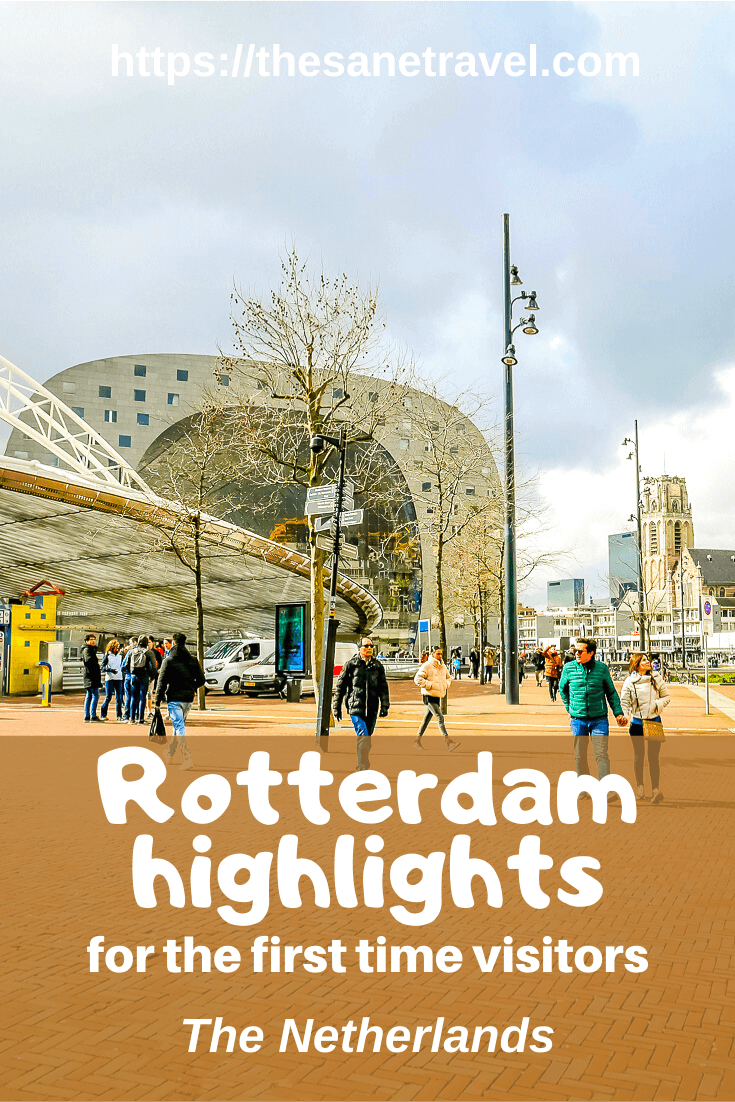
What did you think? Have you been to Rotterdam? I’d love to hear from you so please add your comments below.
Author: Anita Sāne

About the author
Anita is a part-time traveller, passionate photographer and a retired career woman from Latvia, travelling mostly solo for more than 15 years. She is a skilled travel planner who plans and executes her travels by herself. Anita wants to show you how to travel the world and open your mind to new experiences. Follow her on Facebook, Instagram, Pinterest, Twitter and Bloglovin.

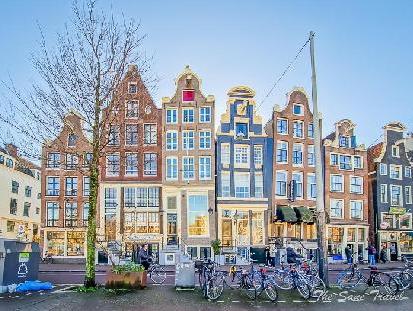
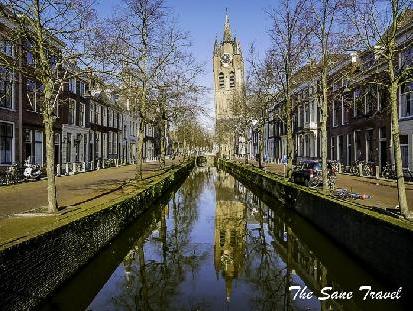
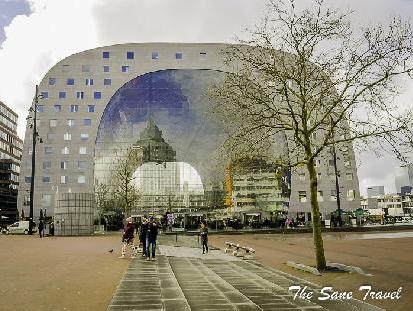
Report
My comments